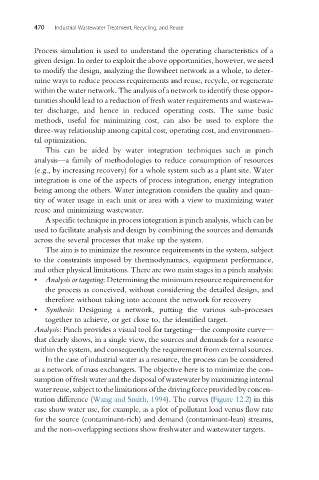Page 500 - Industrial Wastewater Treatment, Recycling and Reuse
P. 500
470 Industrial Wastewater Treatment, Recycling, and Reuse
Process simulation is used to understand the operating characteristics of a
given design. In order to exploit the above opportunities, however, we need
to modify the design, analyzing the flowsheet network as a whole, to deter-
mine ways to reduce process requirements and reuse, recycle, or regenerate
within the water network. The analysis of a network to identify these oppor-
tunities should lead to a reduction of fresh water requirements and wastewa-
ter discharge, and hence in reduced operating costs. The same basic
methods, useful for minimizing cost, can also be used to explore the
three-way relationship among capital cost, operating cost, and environmen-
tal optimization.
This can be aided by water integration techniques such as pinch
analysis—a family of methodologies to reduce consumption of resources
(e.g., by increasing recovery) for a whole system such as a plant site. Water
integration is one of the aspects of process integration, energy integration
being among the others. Water integration considers the quality and quan-
tity of water usage in each unit or area with a view to maximizing water
reuse and minimizing wastewater.
A specific technique in process integration is pinch analysis, which can be
used to facilitate analysis and design by combining the sources and demands
across the several processes that make up the system.
The aim is to minimize the resource requirements in the system, subject
to the constraints imposed by thermodynamics, equipment performance,
and other physical limitations. There are two main stages in a pinch analysis:
• Analysis or targeting: Determining the minimum resource requirement for
the process as conceived, without considering the detailed design, and
therefore without taking into account the network for recovery
• Synthesis: Designing a network, putting the various sub-processes
together to achieve, or get close to, the identified target.
Analysis: Pinch provides a visual tool for targeting—the composite curve—
that clearly shows, in a single view, the sources and demands for a resource
within the system, and consequently the requirement from external sources.
In the case of industrial water as a resource, the process can be considered
as a network of mass exchangers. The objective here is to minimize the con-
sumption of fresh water and the disposal of wastewater by maximizing internal
water reuse, subject to the limitations of the driving force provided by concen-
tration difference (Wang and Smith, 1994). The curves (Figure 12.2) in this
case show water use, for example, as a plot of pollutant load versus flow rate
for the source (contaminant-rich) and demand (contaminant-lean) streams,
and the non-overlapping sections show freshwater and wastewater targets.

